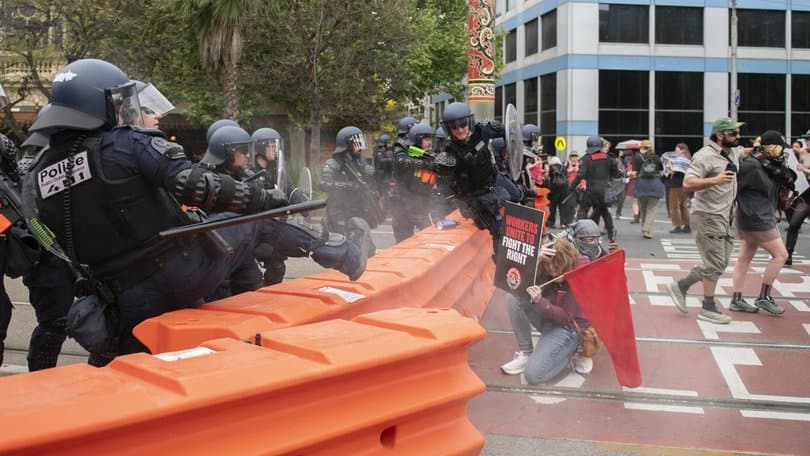Loading News Article...
We're loading the full news article for you. This includes the article content, images, author information, and related articles.
We're loading the full news article for you. This includes the article content, images, author information, and related articles.
Clashes between anti-immigration and anti-racism protesters in Melbourne's CBD led to injuries among police officers, raising concerns about public order in urban centres.

Two police officers were hospitalised in Melbourne, Australia, on Sunday, October 19, 2025, after violent confrontations erupted between anti-immigration and anti-racism demonstrators. The incident, which saw counter-protesters allegedly pelting officers with rocks and bottles, has drawn condemnation from Victorian Premier Jacinta Allan, who attributed the violence to a “very small number” of counter-protesters.
The clashes occurred in Melbourne's Central Business District (CBD) as police attempted to separate an anti-immigration rally, organised by 'March for Australia', from a counter-protest dubbed 'United Against Racism: Migrants and Refugees Are Welcome'.
While this incident occurred in Australia, the dynamics of public demonstrations and the potential for violence resonate globally, including in Kenya. In Kenya, public protests are a constitutional right, but they are often met with significant police presence and, at times, force, particularly when they are perceived to disrupt public order or involve contentious political issues. The Public Order Act (Cap 56) in Kenya governs public gatherings, requiring organisers to notify the police in advance. However, enforcement and interpretation of these laws have often been subjects of debate, with civil society groups advocating for greater protection of assembly rights.
Victorian Premier Jacinta Allan maintained that Melbourne is safe and that police possess the necessary powers to maintain order. This statement underscores the ongoing challenge for governments worldwide to balance freedom of assembly with the need to ensure public safety and prevent violence during demonstrations. In Kenya, the National Police Service Act and the Public Order Act provide the legal framework for managing protests. The Independent Policing Oversight Authority (IPOA) also plays a crucial role in investigating police conduct during such events, aiming to ensure accountability and adherence to human rights standards.
Superintendent Wayne Cheesman of Victoria Police stated on Sunday that counter-protesters were “desperately” trying to reach the anti-immigration rally, leading officers to deploy flash bangs, pepper spray, and rubber bullets to keep the groups apart. He further noted that the counter-protesters threw large rocks, glass bottles, and spoiled fruit at officers while attempting to breach police barricades. In contrast, Superintendent Cheesman described the organisers of the anti-immigration rally as “peaceful, engaging and they did what they were told.”
The incident highlights the inherent risks associated with protests involving opposing ideologies, particularly when emotions run high. For Kenya, similar scenarios could escalate quickly, posing significant challenges for law enforcement and potentially leading to property damage, injuries, or even fatalities. The use of force by police, while sometimes necessary to control violent situations, also carries the risk of further inflaming tensions and eroding public trust, a concern often raised by human rights organisations in Kenya.
While Premier Allan attributed the violence to a “very small number” of counter-protesters, the specific motivations and affiliations of these individuals remain under scrutiny. The extent to which the violence was premeditated or a spontaneous reaction to the presence of opposing groups is also a subject of ongoing investigation. In Kenya, the identification of instigators in protest-related violence often proves challenging, leading to debates about accountability and due process.
The two injured officers have been discharged from hospital but will be off duty for several weeks. Police investigations into the incident are ongoing, with potential arrests and charges expected. The long-term implications for protest management in Melbourne, and by extension other global cities facing similar challenges, will likely involve a review of policing tactics and public order strategies.
Observers will be keen to see the outcome of police investigations and any subsequent legal proceedings. The incident may also prompt a broader discussion on the regulation of public demonstrations and the role of social media in mobilising and potentially radicalising protesters. In Kenya, ongoing efforts to reform the police service and enhance community policing initiatives will be crucial in addressing similar challenges.
Keep the conversation in one place—threads here stay linked to the story and in the forums.
Other hot threads
E-sports and Gaming Community in Kenya
Active 6 months ago
Popular Recreational Activities Across Counties
Active 6 months ago
The Role of Technology in Modern Agriculture (AgriTech)
Active 6 months ago
Investing in Youth Sports Development Programs
Active 6 months ago